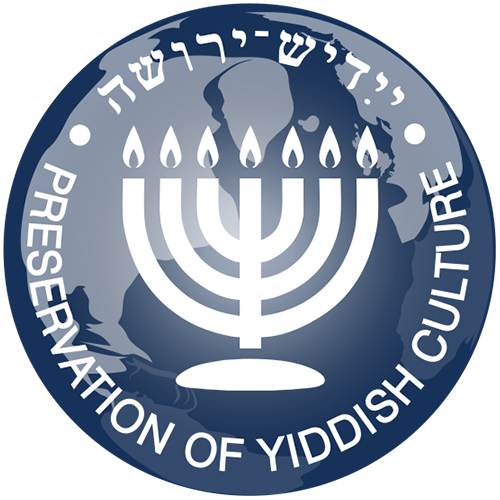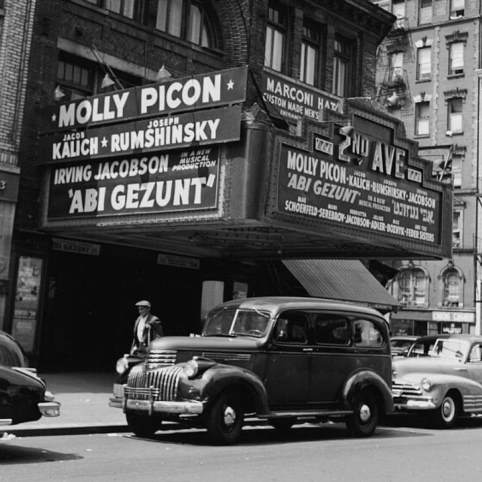Yiddish Theater in Early 20th
Century New York
In the first half of the 20th century, New York had become the home of the largest Jewish city community in the world because of a gigantic wave of Eastern European immigrants who fled from pogroms or discrimination, or who simply hoped to find a better life in the new world. Between 1880 and 1924, about two and a half million Jews arrived in the US. Most of them eventually settled in New York. During this time period, the Lower East Side of Manhattan was the main Jewish neighborhood of the city, and the nearby area between the Second Avenue, Avenue B, Houston Street and East 14th Street had acquired the reputation of the Yiddish Theatre District or Yiddish Broadway.
By 1914, as many as 22 Yiddish drama theaters and two operetta theaters operated in New York, including David Kessler’s Second Avenue Theatre, Boris Tomashevsky’s National Theater and Jacob Adler’s Grand Theatre. Among various reasons that led to such flourishing of Yiddish theatrical life in early 20th century New York, three factors are of the greatest importance.
1) The ban on Yiddish theater in the Russian Empire
After its emergence and blossoming development in the Russian empire, theatrical performances in Yiddish were suddenly banned in 1883, which for many Jewish actors, directors and playwrights meant the end of their careers. Many of these professionals had no other choice but to leave Russia. Quite a few of them eventually ended up in New York. Although the ban was lifted in 1904, it caused a long-lasting effect.
2) Jewish mass emigration to the US
The difficulties that the Jewish theatrical professionals experienced in Russia coincided with the general mass emigration of Russian Jews. As mentioned above, this eventually resulted in New York becoming a city with the largest Jewish community in the world. Naturally, these theater figures found a large audience among the arriving immigrants.
3) Growing popularity of theater among the Jewish immigrants
Since the mid-18th century, New York had a significant theater presence. Gradually, New York theater centered in the midtown Manhattan, in the area now known as the Theatre District. The Jewish immigrants, who settled in the nearby area, wanted their own entertainment in their own language. Theater became popular among Jewish workers who, after a difficult work day, sought an element of cultural fun in their life. The “Yiddish Broadway” had begun to flourish soon after its emergence. During the same single evening, admirers of particular theater and actors (their patryotn – patriots, as they would say in Yiddish) would gather at dozens of various performances. The Yiddish theater become a well known city phenomenon. News about it often appeared on the pages of New York newspapers, both in Yiddish and English.
The Yiddish theater reached its peak at the end of the 1930s. Its slow loss of popularity roughly coincided with WWII. We will outline two main reasons of this gradual downfall.
1) Assimilation
While the first generation of immigrants spoke Yiddish on a daily basis, many of their children and grandchildren grew up fluently speaking English and well integrated into the general American society. Typically, they would prefer American theaters who played in English.
2) The Holocaust
In 1924, the US Congress introduced immigration quotas that substantially limited the flow of new immigrants. During WWII, these quotas remained in place, making escape from the Nazi genocide to the USA very difficult for the Jews. The number of Jewish refugees who managed to immigrate to the United States during the war was relatively small.
The tragic events of the WWII undermined the global future of Yiddish. Before the war, the language was spoken by about 11 million people. Of the 6 million Eastern European Jews who were killed during the Holocaust, the vast majority were Yiddish speakers. Today, in the 21th century, only about 500 thousand people use Yiddish as an everyday language (although reports vary). Most of them are ultra-Orthodox Jews for whom even viewing, let alone organizing secular theatrical performances, is forbidden as a sinful activity associated with heretical worldviews.
Nowadays, the streets of Low East Side and the East Village are still associated with rich cultural life, but little reminds us of their Jewish past and of the Yiddish theater that once was the hallmark of these parts of the city. Something certainly worth visiting is the Yiddish Theater Walk of Fame, similar to the Hollywood Walk of Fame, with names of famous actors, playwrights, directors and composers carved on the sidewalk on the corner of Second Avenue and East 10th Street, in front of the building that used to house the famous Second Avenue Deli – another hallmark of the once flourishing Lower Manhattan’s Jewish life. Originally opened at this address in 1954, at the heart of the then declining Yiddish Theater District, and still retaining the same name, it is still operational as a kosher delicatessen at a different location.
The Yiddish Theater Walk of Fame is decorated with the names of such stars as Avrom Goldfaden, Boris Tomashevsky, Molly Picon, Ida Kaminsky, Joseph Buloff, Luba Kadison, Sholom Seсunda, Alexander Olshanetsky, Joseph Rumshinsky, Moishe Oysher, Menashe (Menasha) Skulnik, the Barry Sisters, Herman Yablokoff and Maurice Schwartz. Another historical landmark is the modest limestone building on the East 7th Street, which housed the Hebrew Actors’ Union since 1899, when it was founded, until its closure in 2005. Despite its name, the union’s members played in Yiddish, not in Hebrew.
Of 24 Yiddish theaters that existed in New York before the outbreak of WWII, now remain only two: the National Yiddish Theatre Folksbiene and the New Yiddish Rep (Repertory Theater). Both are highly professional. Folksbiene’s productions are often supplied with English and occasionally Russian subtitles. The New Yiddish Rep calls itself “a multi-lingual theater”, although its main focus is decisively Yiddish.
It’s worth to note that the Yiddish-speaking ultra-Orthodox communities do produce their own theatrical performances, albeit in a peculiar form: gender-segregated, limited to religiously-themed plots devoid of any taint of erotic elements, and usually unprofessional. Some former Hasidim who left their communities have now become professional actors in the aforementioned two theaters. Professional Yiddish theaters that exist today in Tel Aviv and Warsaw influence the ongoing Yiddish theatrical activity in New York.
Thus, I want to believe that not everything is lost. In his Nobel Prize speech of 1978, Isaac Bashevis-Singer said the following: “There are some who call Yiddish a dead language, but so was Hebrew called for two thousand years. It has been revived in our time in a most remarkable, almost miraculous way. Aramaic was certainly a dead language for centuries but then it brought to light the Zohar, a work of mysticism of sublime value. It is a fact that the classics of Yiddish literature are also the classics of the modern Hebrew literature. Yiddish has not yet said its last word. It contains treasures that have not been revealed to the eyes of the world. It was the tongue of martyrs and saints, of dreamers and Kabbalists – rich in humor and in memories that mankind may never forget. In a figurative way, Yiddish is the wise and humble language of us all, the idiom of frightened and hopeful Humanity”.
Let’s hope that the Yiddish theater in New York and it the world will continue to flourish, although its current state may look small and pathetic in comparison with its glorious past. I believe that in order to preserve and further develop this enormously important aspect of Yiddish culture as a living phenomenon, we need also to make some extra efforts: lectures, tours, conferences, articles in Jewish newspapers, magazines, blogs and websites. It is also very important to preserve the memory of its past. As a licensed tour guide specializing in Jewish New York, and as a New York-based Jewish blogger, I see it as an integral part of my mission.
Maya Zeleny


